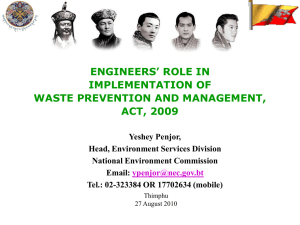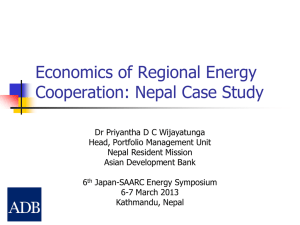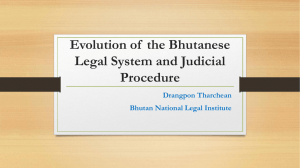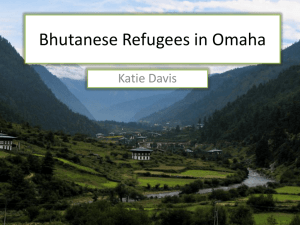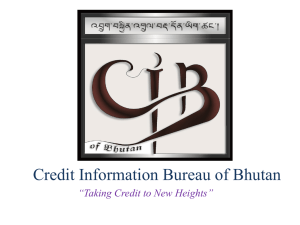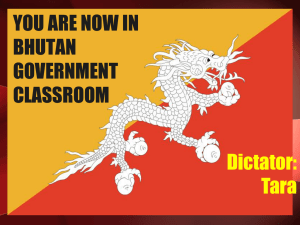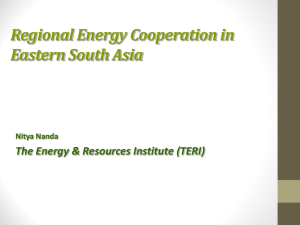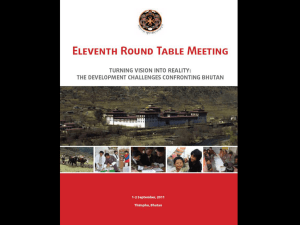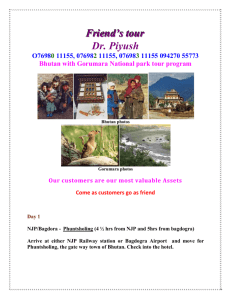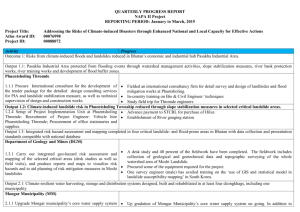Download: Presentation of Mr. Tshering Wangdi
advertisement
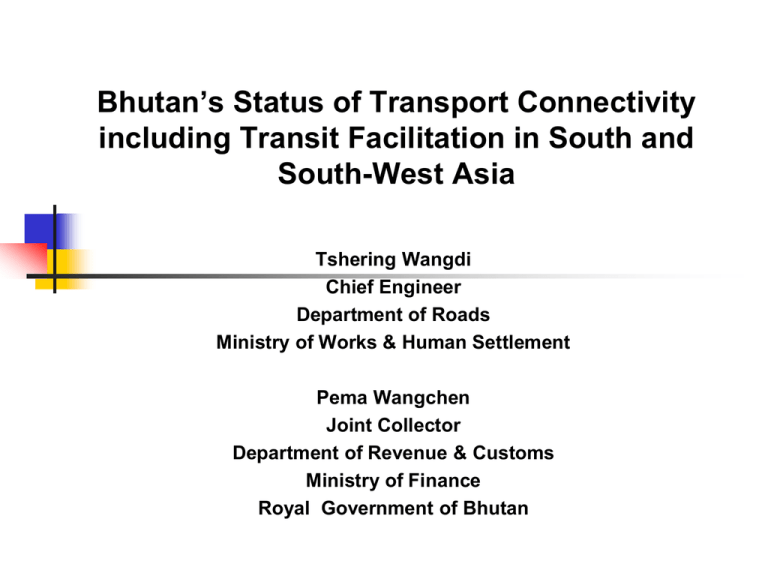
Bhutan’s Status of Transport Connectivity including Transit Facilitation in South and South-West Asia Tshering Wangdi Chief Engineer Department of Roads Ministry of Works & Human Settlement Pema Wangchen Joint Collector Department of Revenue & Customs Ministry of Finance Royal Government of Bhutan COUNTRY LOCATION BHUTAN AT A GLANCE (2013) Area (sq.km) Dzongkhags /Districts Geogs (blocks) Capital Population (2012) Currency National Language Per capita GDP GDP growth rate - Forest cover - 38,394 20 205 Thimphu 7,20,679 Ngultrum Dzongkha Nu.138,132 (2012) 4.6% (2012) 72.5% ROAD TRANSPORT VISION 2020 MILESTONES Bring 75% of rural population within half-day’s walk from nearest road Upgrade current national trunk roads to carry 30-ton capacity trucks Complete second transnational highway (Southern E-W Highway) Construct “dry ports” at Phuentsholing, Gelephu, and Samdrupjongkhar Introduce domestic air services Improve external air links with full ILS capacity ROAD SECTOR MASTER PLAN (2007 – 2027) Construction of Southern East-West highway (794 km) –Primary National H/way) New construction Upgradation : 506 km : 288 km Secondary National H/way (inter Dzongkhag connectivity) : 537 km Dzongkhag Roads : 2654 km TRANSPORTATION SYSTEM Road is the principle mode of transport in the country Construction began in early sixties and the national road network expanded over 10,000km All twenty districts are connected by road network Road construction in the country is costly and challenging due to rugged mountainous terrain Air services operate to nine destinations in five countries: Delhi, Kolkata,Gaya,Guwahati,Bagdogra (all in India) TRANSPORTATION SYSTEM CONTD. Air services operate to nine destinations in five countries:Delhi,Kolkata,Gaya,Guwahati,Bagdogra (all in India) Dhaka,Katmandu,Bangkok and Singapore. A private airline has been licensed and commenced operation in 2013 Domestic air services commenced since December 2011 No rail transport, no inland water transport and no dry port Passenger and freight in land transport fully privatized TRANSPORTATION SYSTEM CONTD. Motorization has been rapid with the number of vehicles increasing from 13,584 in 1997 to 67,499 in 2012 with an annual increase of about 11% Overall 100 vehicles for every 1000 population Vehicle model split Trucks/Buses -14% Light vehicles/passenger cars -58% 2Wheelers -14% Taxis -08% Others -06% HIGHWAY NETWORK ROAD NETWORK IN KM (June 2013) Expressway Primary National Highway Secondary National Highway Dzongkhag Road Thromde (Urban) Road Farm Road Access road 6 1860 578 1178 350 5376 1230 --------------------------Total: 10578 ----------------------------- 11th 5 YEAR PLAN PROGRAMMES (July 2013 to June 2018) Construction of Primary National H/way - 305 km Upgradation of National Highways - 562 km Construction of Dzongkhag Road - 122 km PHUENTSHOLING – THIMPHU HIGHWAY (AH48) Year of construction Length (km) -1968 -179 Section Length Phuentsholing-Chukha Chukha-Damchu Damchu-Thimphu 82.5 km 43.5 km 53.0 km Present traffic volume No. of Lanes 2 1 2 - Class II III II 1500-2000 vpd ASIAN HIGHWAY (AH48) FROM PHUENTSHOLING TO THIMPHU STATUS: Phuentsholing to Chukha (82.5km) - completed Chukha to Damchu Bypass (24 km): Formation cutting Blacktopping Completion date Damchu toThimphu (53km) - 98% complete - 44% complete - 2015 - completed CONSTRUCTION OF SOUTHERN EAST-WEST HIGHWAY (SEWH) - 723 km Existing Missing links - 338 km - 385 km Connect economic hubs in southern part of the country and onward connection to India Link to the Asian Highway Network in the subregion and beyond TRANSPORT LOGISTICS - INTERNATIONAL CONNECTIVITY International Airport (Paro) 1 No. Domestic Airports 3 Nos. (Bumthang, Yonphula, Gelephu) Nearest international sea-port is Kolkata in India (750 km by road from Phuentsholing) Nearest railway stations from Bhutan: -Rangia, Bongaigaon, Kokrajhar (Assam, India) -Hashimara, Alipurduar, New Jalpaiguri (W.Bengal, India) ROAD LINKAGE TO NEIGHBORING COUNTRIES Point in BHUTAN Phuentsholing Samtse Gelephu Samdrupjongkhar Nganglam Gomtu (Pugli) Point in INDIA Jaigaon Chamurchi Dadghari Darranga Pathsala Birpara INTERNATIONAL CONNECTIVITY AH48 Thimphu-Phuentsholing in Bhutan AH48 &AH2 (for connectivity with India,Nepal & Bangladesh) Phuentsholing-Jaigoan-Hashimara-Phulbari-PanitankiKakarvita for Bhutan, India & Nepal Phuentsholing-Jaigoan-Hashimara-ChangrabandhaBurimari-Banglabandha for Bhutan, India & Bangladesh CORRIDORS IDENTIFIED UNDER SASEC ROAD CONNECTIVITY PROJECT Nganglam-Dewathang H/way (75km) Pasakha Access Road (2km) Northern bypass in Phuentsholing (2.7km) Mini Dry Port at Phuentsholing Study for links for regional connectivity from Gomtu/Pugli to Dalmore/Birpara and Motanga(Bhutan)/Bokajuli(India) CORRIDORS IDENTIFIED UNDER SAARC REGIONAL MULTIMODAL TRANSPORT STUDY (SRMTS) Road corridors: 1. Thimphu-Phuentsholing-Jaigaon-HashimaraKolkata/Haldia 2. Thimphu-Phuentsholing-JaigaonBurimari(Bangladesh)-Mongla/Chittagong 3. Samdrup Jongkhar-Guwahati-ShillongShilhet(Bangladesh)-Dhaka-Kolkata 4. Thimphu/Paro-Phuentsholing-HashimaraSiliguri-Kakarvita (Nepal) CORRIDORS IDENTIFIED UNDER SAARC REGIONAL MULTIMODAL TRANSPORT STUDY (SRMTS) Rail corridor: Pasakha-Toribari-Hashimara (India) Feasibility study being carried by Government of India to connect five border towns in Bhutan from the nearest Indian railheads. CROSS-BORDER TRAFFIC MOVEMENT Being landlocked, sub-regional, regional and international connectivity by land transport is possible through India only Phuentsholing near Jaigaon in West Bengal is the main gateway for international trade (over 82%) About 55%import and 94% export takes place with India Trade with other countries within the SAARC region is marginal Transport connectivity with Nepal and Bangladesh is possible through India only Sea port in India (Kolkata and Haldia) are the main Maritime gateways for international trade with other countries other than Nepal and Bangladesh KEY CHALLENGES FOR ROAD INFRASTRUCTURE DEVELOPMENT AND TRANSIT TRANSPORT OPERATION High construction and maintenance cost due fragile, rugged mountainous terrain and winding roads Shortage of fund Fledgling construction industry Lack of appropriate construction technology Shortage of trained manpower Transport and transit through India in absence of Inland container depot Small volume of cargo makes it unfeasible to book railway wagons or use bigger containers to and from the sea port. SUB- REGIONAL AND REGIONAL TRADE FACILITATION INITIATIVES Accession to the Revised Kyoto Convention (RKC) -ADB assistance being sought under ADB funded SASEC Trade Facilitation Program to assess and update Bhutan’s legal and regulatory regime for accession to RKC; Automated customs management -Automated Customs Systems (ACS) being replaced by Revenue Administration Management Information System (RAMIS) being developed under ADB funded TA SAARC Regional Multimodal Transport Study adopted in 2007 South-Asian Sub-Regional Economic Cooperation Program of the ADB completed in 2005 covering 4 countries: India, Nepal, Bangladesh and Bhutan Bay of Bengal Initiative for multi-Sectoral Technical and Economic Cooperation or BIMSTEC Transport Infrastructure and Logistics Study covering Bangladesh, Bhutan, India, Myanmar, Sri-lanka and Thailand. Bilateral Trade and Transit Agreement Agreement on Trade and Commerce with India. Allows free trade between the two countries through designated entry and exit points Transit of cargo from sea-ports are subject to very minimal checks There is also free movement Bhutan registered vehicles in India Agreement on Trade and Commerce with Bangladesh International trade takes place through 6 entry and exit points from the Indian side and 8 from the Bangladesh side Agreement on Trade and Commerce with Nepal No formal trade and transit agreement so far.Panitanki near Siliguri in India is designated as the transit route for Bhutan-Nepal trade Bhutan Customs: Current Status For Third country Imports- majority of the goods are transported in containerized cargo. Goods coming from India- are transported in open trucks Free entry and exit of vehicle to the country within proximity 7-10 KM Multi-enforcement agencies involved to clear the goods BHUTAN CUSTOMS: CHALLANGES Lack of tracking equipments for tracking the movement of good for predictability purpose Goods transported in open truck rather than in containerized vehicle. Lack of multi-access bypass from importing country to exporting countries. Bad road condition. Multi check post on the highways (local authorities) Timely border coordination meetings THANK YOU & TASHI DELEK
